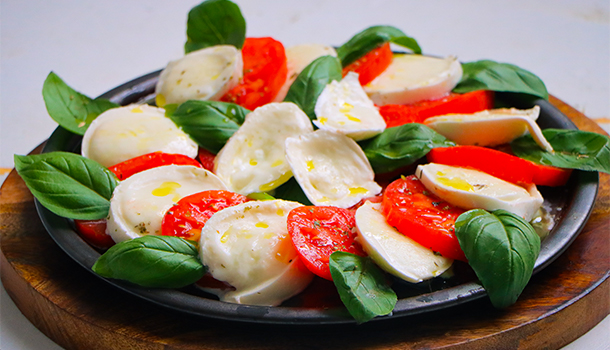Caprese Recipe: The Caprese salad is one of those classic Italian dishes that has stood the test of time with grace. It’s incredibly simple but packs a punch when it comes to flavor. Imagine biting into juicy tomatoes, creamy mozzarella, and fresh basil leaves, all kissed with a splash of olive oil—mouthwatering, right? That’s Caprese. It’s a no-fuss, no-cook recipe that celebrates fresh ingredients and brings a taste of the Mediterranean to your plate.
Unlike salads that are tossed or chopped, a Caprese is all about layering and presentation. Each slice is arranged to highlight its vibrant colors and textures, making it not only delicious but visually appealing. The dish gets its name from the island of Capri in Italy, which is where it originated. It’s essentially summer on a plate and a favorite appetizer for many.
Origin and Cultural Significance
Caprese salad was first introduced in post–World War I Italy as a tribute to the colors of the Italian flag—red, white, and green. It’s more than just a salad; it’s a symbol of national pride and culinary identity. Over the years, it’s found its way into restaurants and home kitchens around the world, becoming a staple for those who appreciate light and healthy fare.
What makes Caprese so iconic is its celebration of seasonal, fresh produce. In Italy, this dish is traditionally served as an “antipasto,” or starter, before the main course. It exemplifies the Mediterranean diet, known for its health benefits and longevity. Today, Caprese is enjoyed in countless variations, but its essence remains the same: fresh, flavorful, and authentically Italian.
Ingredients You’ll Need
Fresh and Simple Ingredients
The magic of Caprese lies in its simplicity. Here’s what you’ll need:
- Tomatoes: Ripe, juicy tomatoes are the star. Go for heirloom, Roma, or vine-ripened tomatoes.
- Mozzarella Cheese: Fresh mozzarella or buffalo mozzarella works best. It should be soft and creamy.
- Fresh Basil Leaves: Avoid dried basil—fresh is essential for that aromatic touch.
- Extra Virgin Olive Oil: A good-quality olive oil enhances flavor and adds richness.
- Salt & Pepper: Just a pinch to season everything.
Optional additions:
- Balsamic glaze or vinegar for a tangy twist.
- Garlic or herbs like oregano if you want more complexity.
Tips for Choosing the Best Ingredients
When it comes to Caprese, quality is everything. Since you’re working with just a handful of ingredients, each one needs to be top-notch.
- Tomatoes should be firm but ripe. Avoid overly soft or bland varieties.
- Mozzarella should be stored in water if it’s fresh. Always drain it before slicing.
- Basil should be bright green without black spots.
- Olive oil matters more than you think. Use cold-pressed, extra virgin for best results.
- Try sourcing from local farmer’s markets for peak freshness—especially during summer months.
Tools and Utensils Required
Basic Kitchen Tools for Prep
The good news? You don’t need a gourmet kitchen to make Caprese. Here’s a quick checklist of what you’ll need:
- A sharp chef’s knife or serrated knife
- A clean cutting board
- A serving plate or platter
- Tongs or spoons (optional for serving)
Optional Gadgets for Perfection
Want to elevate your Caprese game?
- Mandoline slicer: Helps achieve uniform tomato slices.
- Herb scissors: Perfect for snipping fresh basil.
- Oil dispenser: For a controlled olive oil drizzle.
Step-by-Step Guide to Making Caprese Salad
Step 1: Preparing Your Ingredients
Start by washing your tomatoes and basil leaves thoroughly. Pat them dry with a clean kitchen towel. If you’re using buffalo mozzarella packed in water, drain it well to avoid a soggy plate.
This step is all about mise en place—having everything ready to go. Lay out your cutting board, knife, and serving platter so you’re set up for smooth execution.
Step 2: Slicing Tomatoes and Mozzarella
Slice your tomatoes into even, round slices—about 1/4 inch thick. Repeat the same with your mozzarella. Uniform slices ensure that every bite has a balanced flavor.
If you’re working with heirloom tomatoes, expect some irregular shapes—that’s part of the charm!
Step 3: Arranging the Layers
Now for the fun part—assembling. On your platter, alternate slices of tomato and mozzarella in a slightly overlapping circular or row pattern. Tuck a fresh basil leaf between each slice.
You want the colors to pop: red tomato, white mozzarella, green basil. It’s a visual delight and a nod to the Italian flag.
Step 4: Adding Basil Leaves
Tear (don’t cut) the basil leaves gently with your hands. Cutting with a knife can bruise the leaves and dull their flavor. Scatter the torn basil generously over the top of your arrangement.
The scent of fresh basil starts to mingle with the tomato juice and cheese—it’s culinary perfume.
Step 5: Seasoning and Drizzling with Olive Oil
Finally, sprinkle a pinch of salt and a dash of freshly ground black pepper across the top. Then, take your best olive oil and drizzle lightly over the salad. Don’t overdo it—you want a glistening finish, not an oil bath.
For a modern twist, drizzle a balsamic glaze in a zigzag motion over the top. It adds both tanginess and elegance.
Presentation Tips for a Stunning Caprese
Plate Like a Pro
Let’s be honest—Caprese salad is all about aesthetics as much as it is about flavor. That means how you present your dish matters. Whether you’re serving guests or just treating yourself, a beautifully plated Caprese can elevate the entire dining experience.
Start with a large, flat platter if you’re making this for a crowd. Arrange the tomato and mozzarella slices in a spiral or straight row. Make sure the edges of each slice overlap slightly—it creates a continuous flow of colors and textures. For single servings, a small round plate works perfectly; you can even use a ring mold to stack the layers for a modern, vertical presentation.
Add the basil leaves just before serving so they stay vibrant and don’t wilt. Lastly, give your dish a final flourish with an extra drizzle of olive oil and, if desired, a light dusting of flaky sea salt or a few cracks of black pepper. If you’re going all out, a few edible flowers or microgreens can take your presentation to the next level.
Serving Suggestions
Caprese salad is extremely versatile. You can serve it as:
- An appetizer: A light and refreshing start to any meal.
- A side dish: Perfect alongside grilled meats, pasta, or seafood.
- A main course: Just add some crusty bread or grilled chicken to make it more filling.
Pair it with a crisp white wine like Pinot Grigio or a light-bodied red like Chianti for that full Italian experience. It’s also a fantastic addition to brunch spreads and picnic baskets.
The simplicity of Caprese makes it the perfect dish to serve any time of the year, but it truly shines in summer when tomatoes and basil are in peak season.
Variations of Caprese Salad
Grilled Caprese
Want to give your Caprese a smoky twist? Try grilling the tomatoes. Cut them into thick slices, brush lightly with olive oil, and grill for 1–2 minutes per side. This caramelizes the natural sugars and adds a depth of flavor that contrasts beautifully with cool mozzarella.
You can also warm the mozzarella slightly for a gooey, melt-in-your-mouth texture. Just be careful not to overheat it, or it will lose its shape.
Top with fresh basil, a pinch of sea salt, and a drizzle of balsamic glaze. The smoky-sweet combination is unforgettable.
Caprese Skewers
Caprese on a stick? Yes, please. Caprese skewers are perfect for parties, BBQs, and potlucks.
Here’s what you’ll need:
- Cherry or grape tomatoes
- Mozzarella balls (bocconcini)
- Fresh basil leaves
- Skewers or toothpicks
Thread one tomato, one mozzarella ball, and one basil leaf onto each skewer. Repeat until filled. Arrange on a platter, drizzle with olive oil and balsamic glaze, and you’ve got a crowd-pleaser that’s easy to grab and go.
Caprese with Balsamic Glaze
While traditional Caprese doesn’t include balsamic, the modern twist of adding a balsamic glaze has become wildly popular—and for good reason. The glaze adds a sweet-tart contrast that enhances every bite.
You can buy balsamic glaze at most grocery stores or make your own by reducing balsamic vinegar over low heat until thick and syrupy.
Drizzle sparingly to avoid overpowering the delicate flavors of the salad. It’s the perfect balance of tangy, sweet, and savory.
Health Benefits of Caprese Salad
Nutritional Value
Caprese salad isn’t just delicious—it’s also incredibly healthy. With just a few wholesome ingredients, it offers a great mix of vitamins, minerals, and healthy fats.
Here’s what you get:
- Tomatoes: Rich in Vitamin C, potassium, and antioxidants like lycopene, which may help reduce the risk of heart disease and certain cancers.
- Mozzarella: A good source of protein and calcium. It’s lower in fat compared to many other cheeses, especially if you opt for part-skim versions.
- Basil: Contains Vitamin K, iron, and anti-inflammatory compounds.
- Olive Oil: Full of heart-healthy monounsaturated fats and antioxidants.
Put it all together, and you’ve got a meal that supports heart health, reduces inflammation, and keeps you full and satisfied without weighing you down.
Why It’s a Healthy Choice
Caprese salad aligns beautifully with the principles of the Mediterranean diet, which emphasizes fresh produce, lean proteins, and healthy fats. It’s low in carbs, gluten-free, and can be made vegetarian or even keto-friendly with a few tweaks.
This makes it ideal for those looking to eat clean without sacrificing flavor. It’s also quick to prepare and easy to digest—perfect for a light lunch or a healthy snack.
For those watching sodium intake, just go easy on the added salt and opt for unsalted mozzarella. Want to reduce calories? Use part-skim mozzarella and control your portion of olive oil.
Caprese is proof that eating healthy doesn’t have to mean eating bland.
Common Mistakes to Avoid
Ingredient Pitfalls
While Caprese salad is deceptively simple, it’s surprisingly easy to mess up if you’re not careful. The most common mistake? Using subpar ingredients. This dish thrives on freshness—any compromise in quality immediately dulls the flavor.
Here are a few traps to avoid:
- Unripe or tasteless tomatoes: If your tomatoes are hard or flavorless, the salad will lack that juicy sweetness that makes Caprese so enjoyable.
- Pre-packaged mozzarella: Mozzarella that’s been vacuum-sealed or shredded just doesn’t have the same creamy texture or delicate flavor as fresh mozzarella or buffalo mozzarella.
- Wilted basil: Old or bruised basil leaves can make your salad look and taste tired.
- Low-quality olive oil: Don’t grab the cheapest bottle on the shelf. Poor-quality oil can be bitter and overpowering, ruining the delicate balance.
It’s also important to use the right kind of salt. Table salt can be too harsh. Opt for sea salt or flaky salt to season gently and enhance the natural flavors.
Overcomplicating the Simplicity
Caprese is meant to be a minimalist dish. Adding too many extras or trying to “fancy it up” can quickly detract from its charm.
Avoid these over-the-top additions:
- Too many herbs: A little oregano or thyme can work in some variations, but overdoing it will mask the basil.
- Too much vinegar or glaze: A drizzle of balsamic is fine, but drowning your salad in it will overpower the cheese and tomatoes.
- Odd toppings: Ingredients like nuts, fruits, or even croutons may sound interesting but they don’t belong in a traditional Caprese.
Stick to the classic trio—tomato, mozzarella, basil—and you’ll never go wrong. Trust the simplicity, and let the freshness speak for itself.
Storage and Leftover Tips
How to Store Properly
Caprese salad is best enjoyed fresh, right after it’s assembled. But if you’ve made a large batch or have leftovers, proper storage is key to keeping it delicious.
Here’s how to do it:
- Use an airtight container: Place your salad in a shallow container with a tight-fitting lid. Make sure it’s not overcrowded, as the ingredients are delicate.
- Refrigerate immediately: Store the salad in the fridge within an hour of serving. It will keep for up to 24 hours, but the sooner you eat it, the better.
- Avoid freezing: Freezing tomatoes or mozzarella alters their texture, turning them mushy or rubbery. Always keep this dish refrigerated.
If you’re planning ahead, store the sliced components separately. That way, you can assemble the salad just before serving and maintain that fresh, vibrant look.
Creative Ways to Use Leftovers
Got leftover Caprese? Don’t toss it—repurpose it! Here are some tasty ideas:
- Caprese Sandwich: Layer the ingredients on a baguette or ciabatta roll. Add a smear of pesto or a touch of balsamic glaze, and you’ve got a gourmet sandwich.
- Caprese Pasta: Chop up the leftover salad and mix it into freshly cooked pasta. Add a splash of pasta water and olive oil for a quick, flavorful meal.
- Stuffed Chicken Breast: Use the tomato, mozzarella, and basil as a filling for boneless chicken breasts. Bake until the chicken is cooked and the cheese is melty.
- Flatbread or Pizza Topping: Use the ingredients on top of store-bought flatbread or pizza dough. Bake until bubbly and golden.
These ideas not only reduce food waste but also give your leftovers new life.
FAQs about Caprese Recipe
Can I make Caprese salad ahead of time?
Yes, but with care. Assemble the sliced ingredients ahead and store them separately. Put everything together just before serving for the best texture and presentation.
Is it okay to use dried basil?
Not really. Fresh basil is essential to Caprese salad’s flavor and aroma. Dried basil lacks the vibrant punch that fresh leaves bring to the dish.
What type of tomatoes work best?
Heirloom, Roma, and vine-ripened tomatoes are top choices. Look for varieties that are juicy, sweet, and vibrant in color for maximum flavor.
Can I use vegan cheese for a dairy-free version?
Absolutely! There are excellent vegan mozzarella alternatives made from cashews, almonds, or soy. Just make sure it melts and slices like traditional mozzarella.
Should Caprese be served cold or at room temperature?
Room temperature is ideal. This brings out the flavors in the tomatoes and cheese. Cold Caprese can dull the taste and texture.
Conclusion
Caprese salad is more than just a pretty plate—it’s a celebration of simplicity, freshness, and authentic Italian flavor. With just five core ingredients, this dish proves that less is often more. Whether you’re making it as an appetizer, side dish, or light meal, Caprese is sure to impress with minimal effort.
From choosing the ripest tomatoes and creamiest mozzarella to mastering the art of presentation, this step-by-step guide gives you everything you need to create the perfect Caprese salad every single time. Stick to high-quality ingredients, avoid common pitfalls, and explore fun variations when you’re in the mood to switch things up.
So next time you’re wondering what to make on a warm evening, reach for this timeless Italian classic. It’s fast, easy, and irresistibly good.
Buon appetito!



